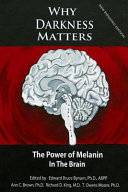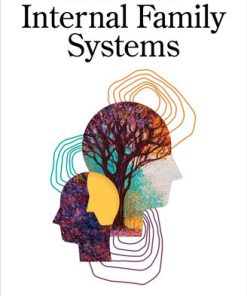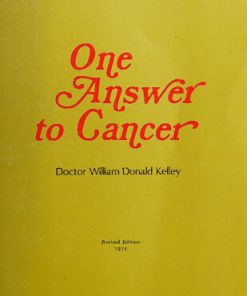Cancer Sensitizing Agents for Chemotherapy Gllioblastoma resistante to chemotherapy series 1st Edition by Benjamin Bonavida ISBN 9780128215678 0128215674
$50.00 Original price was: $50.00.$25.00Current price is: $25.00.
Cancer Sensitizing Agents for Chemotherapy Gllioblastoma resistante to chemotherapy series 1st Edition by Benjamin Bonavida – Ebook PDF Instant Download/Delivery: 9780128215678 ,0128215674
Full download Cancer Sensitizing Agents for Chemotherapy Gllioblastoma resistante to chemotherapy series 1st Edition after payment

Product details:
ISBN 10: 0128215674
ISBN 13: 9780128215678
Author: Benjamin Bonavida
Glioblastoma Resistance to Chemotherapy: Molecular Mechanisms and Innovative Reversal Strategies brings current knowledge from an international team of experts on the science and clinical management of glioblastoma chemoresistance. The book discusses topics such as molecular mechanisms of chemoresistance, experimental models to study chemoresistance, chemoresistance to drugs other than Temozolomide, and specific strategies to reverse chemoresistance. Additionally, it encompasses information on how to mitigate chemoresistance by targeted enhancement of p53 function. This book is a valuable resource for cancer researchers, oncologists, neuro-oncologists and other members of the biomedical field.
Glioblastoma (GBM) is the most invasive and malignant primary brain tumor in humans with poor survival after diagnosis, therefore it is imperative that molecular and cellular mechanisms behind therapy resistant GBM cells, as well as the therapeutic strategies available to counter the resistance are comprehensively understood.
- Provides comprehensive, core knowledge related to the entire discipline of glioblastoma chemoresistance, from its many etiological mechanisms, to specific strategies to reverse resistance
- Presents current information from an international team of experts on the basic science, pre-clinical research, and clinical management of glioblastoma chemoresistance
- Discusses molecular and cellular mechanisms behind therapy resistant glioblastoma cells, as well as the therapeutic strategies available to counter this resistance
Cancer Sensitizing Agents for Chemotherapy Gllioblastoma resistante to chemotherapy series 1st Edition Table of contents:
Chapter-1—Overview-of-glioblast_2021_Glioblastoma-Resistance-to-Chemothera
Overview of glioblastoma biological hallmarks and molecular pathology
Introduction
Biological hallmarks
Pseudopalisading necrosis
Microvascular hyperplasia and angiogenesis
Local invasion
Altered metabolism
Immunosuppressive microenvironment
Heterogeneity and cancer stem-like cells
Molecular pathology
Molecular markers
1p/19q codeletion
Isocitrate dehydrogenase
EGFR
p53 pathway
PTEN and PI3K-AKT pathway
Rb pathway
Ras/Raf/MAPK pathway
Extrachromosomal DNA
Epigenetic markers
MGMT methylation
Telomerase reverse transcriptase
ATRX
Conclusions and future perspectives
References
Chapter-2—Past-and-present_2021_Glioblastoma-Resistance-to-Chemotherapy–M
Past and present drug treatments for glioblastoma
Introduction
Brief history of glioblastoma
Pre-Stupp era
Standard of care for glioblastoma (2005 to now)
Chemotherapy
Tyrosine kinase pathway
EGFR pathway
VEGF
Pl3K/mTOR pathway
Met
Immunotherapy
Conclusion
References
Chapter-3—Investigational_2021_Glioblastoma-Resistance-to-Chemotherapy–Mo
Investigational new drugs against glioblastoma
Introduction
Special challenges
Concepts to explain failure
Temozolomide, the prototype of antiglioma drugs
Agents that target DNA integrity
Agents that induce direct DNA damage
Agents that impair DNA repair
DNA protein kinase inhibitors
Telomerase inhibition
Agents that target epigenetic determinants of chromosome structure and gene transcription
Modulators of chromatin organization
Histone deacetylase inhibitors
Histone methylase inhibitors
Agents that directly alter cell cycle or cell death regulation
Targeting cell cycle regulation
CDK4/6 inhibitors
Drugs that interfere with the mitotic spindle
Targeting the apoptotic circuitry
Direct proapoptotic agents
Agents that directly alter protein homeostasis
Inhibition of the ubiquitin-proteasome pathway
Inhibition of the neddylation pathway
Targeting upstream molecular pathways
EGFR inhibition
Inhibitors of the PI3K/AKT/mTOR pathway
Pan-PI3K inhibitors
AKT inhibitors
mTORC1/2 inhibitors
Multitarget inhibitors if the PI3K pathway
Inhibition of the RAS/MEK/ERK pathway
Synthetic lethality and drug delivery
Conclusions
Acknowledgments
References
Chapter-4—Molecular-mechanis_2021_Glioblastoma-Resistance-to-Chemotherapy-
Molecular mechanisms in temozolomide-resistant glioblastoma
Introduction
What is glioblastoma?
Treatments for GBM
Chemotherapy for GBM
Molecular events in GBM cells after TMZ treatment
Molecular events in TMZ-resistant GBM cells after TMZ treatment
Innate TMZ-resistant GBM cells
Research models (in vitro, in vivo) for innate TMZ-resistant GBM
Molecular events of innate TMZ-resistant GBMs/PDXs
Acquired TMZ-resistant GBM cells
Research models (in vitro, in vivo) for acquired TMZ-resistant GBMs/PDXs
TMZ-resistance mechanisms in acquired TMZ-resistant GBM/PDX cells
Therapeutic approaches
Therapeutic approaches for GBM treatment
Therapeutic approaches for TMZ-resistant GBM cells to overcome TMZ resistance: Single-agent approach
Targeting DNA repair and DNA damage response enzymes
Signaling pathway inhibitors
Targeting transcription factor and transcriptional regulator
DNA synthesis inhibition
Gene therapy
Ligand and receptor
Metabolism inhibition
miRNA modulation
Therapeutic approaches for TMZ-resistant GBM cells to overcome TMZ resistance: Multitarget approach with TMZ
Therapeutic approaches for TMZ-resistant GBM cells to overcome TMZ resistance: Multitarget approach without TMZ
Clinical trial
Methods for identification of novel targets for sensitizing TMZ
Models for studying modulators of TMZ response in GBM
In vitro models of TMZ resistance
In vivo models of TMZ resistance
Methods used for identifying modulators of TMZ response
Methods for evaluation of a single modulator of TMZ resistance
Methods for genome-wide screening modulators of TMZ resistance
Conclusions and future directions
Acknowledgment
References
Chapter-5—Glioma-stem-cells-and-as_2021_Glioblastoma-Resistance-to-Chemoth
Glioma stem cells and associated molecular mechanisms in Glioblastoma Chemoresistance
Introduction
Glioblastoma
Glioma stem-like cells
Current therapies and the role of GSCs
Surgical resection
Bioavailability of temozolomide
Glioma stem-like cell biology aiding survival
GSC identification
GSC role in resistance to hypoxia
GSC role in angiogenesis
GSC role in immune evasion
The impact of GSC heterogeneity and plasticity on chemoresistance
Specific molecular pathways of GSC resistance to chemotherapy
ATP-binding cassette transporter channel
Methylguanine-DNA-methyltransferase
Mismatch and base excision repair mechanisms
Cell cycle checkpoints
Conclusion
References
Chapter-6—Signaling-in-the-tumo_2021_Glioblastoma-Resistance-to-Chemothera
Signaling in the tumor microenvironment of therapy-resistant glioblastoma
Introduction
TME
Signals from the ECM
Hypoxia
Tumor/stroma interactions
Immune infiltrates-modulators-microglia and macrophages
Self-renewal pathways: WNT
Self-renewal pathways: Notch
Self-renewal pathways: Sonic Hedgehog
Receptor tyrosine kinases
EGFR
RAS/MAPK/ERK
PI3K/AKT/MTOR
JAK/STAT
Phospholipase C (PLC/PKC)
Therapeutic resistance to EGFR inhibition
PDGFR
VEGF
Secreted factors: TGF-β
Secreted factors: BMP
Transcription factors: NF-κB
Effects of therapy on the TME
Radiotherapy
Chemotherapy
Targeting the TME
Conclusion
References
Chapter-7—Intratumoral-heterogene_2021_Glioblastoma-Resistance-to-Chemothe
Intratumoral heterogeneity associated with glioblastoma drug response and resistance
Introduction
Genetic and transcriptomic ITH
Cellular and functional ITH
Molecular mechanisms of treatment resistance
O6-methylguanine-DNA methyltransferase (MGMT) status
Drug efflux pumps
DNA checkpoints
Apoptosis
Cell-intrinsic and -extrinsic mechanisms of resistance
Cell state and the proneural-to-mesenchymal transition
Immune cell and niche interactions
Conclusions
References
Chapter-8—Role-of-apoptosis–autoph_2021_Glioblastoma-Resistance-to-Chemot
Role of apoptosis, autophagy, and the unfolded protein response in glioblastoma chemoresistance
Introduction
Apoptosis
Intrinsic pathway of apoptosis
Extrinsic pathway of apoptosis
Apoptosis mediators
Poly (ADP-ribose) polymerases (PARPs) family protein
Bcl-2 family proteins
Inhibitors of apoptosis proteins (IAPs)
P53
Apoptosis and chemoresistance
Chemoresistance in glioblastoma
Role of Bcl-2 family proteins in chemoresistance of glioma cells
Hypoxia and chemoresistance in glioma cells
Role of p53 in alkylating agent chemoresistance
Role of miRNAs in alkylating agent chemoresistance
Role of defective DNA repair systems in alkylating agent chemoresistance
Autophagy pathway
Autophagy and apoptosis cross talk: self-eating and self-killing processes
The dual roles of autophagy in glioblastoma promotion and suppression
Autophagy involvement in the initiation and overcome chemoresistance in GBM
Autophagy involvement in mechanisms of anticancer activity of alkylating agents
Autophagy involvement in chemoresistance to alkylating drugs in GBM
Endoplasmic reticulum stress, and unfolded protein response (UPR)
Cross talk between UPR, autophagy, and apoptosis
Role of UPR in glioblastoma chemoresistance
Role of UPR branches in GBM-induced chemoresistant to TMZ
GRP78
IRE1
PERK
ATF6
UPR affects chemotherapy-induced cell death in GBM
How simvastatin/TMZ affect GBM chemoresistance
Tissue-engineered tumor models
Bioengineered glioblastoma and neuroblastoma in vitro models
Brain tumor tissue-engineered models for chemotherapeutic evaluations
Conclusion
References
Chapter-9—Role-of-multidrug-resist_2021_Glioblastoma-Resistance-to-Chemoth
Role of multidrug resistance in glioblastoma chemoresistance: Focus on ABC transporters
Introduction
Structure and functions of ABC proteins
Structure of ABC proteins
Functions of ABC proteins
Mechanisms of action of ABC transporters
ABC transporters in glioblastoma
ABCB1 (MDR1, P-glycoprotein)
ABCC1 (MRP1)
ABCG2, breast cancer resistance protein (BCRP)
Clinical value
Conclusion
Acknowledgments
References
Chapter-10—Role-of-mitochondrial-reacti_2021_Glioblastoma-Resistance-to-Ch
Role of mitochondrial reactive oxygen species in glioblastoma drug resistance and strategies for therapeutic …
Introduction
Glioblastoma
TMZ: Mechanism of action and resistance
Additional TMZ mechanism of action
Reactive oxygen species in GBM
GBM and ROS
Metabolism and mitochondrial dysfunction modulate ROS production
Direct and indirect ROS effects
Modulation of ROS scavenging
ROS therapeutic activity in GBM
GBM and HIF-1α activity
Reactive oxygen species and chaperone-mediated autophagy
ROS-CMA axis as a therapeutic target for GBM
Conclusions
Acknowledgments
References
Chapter-11—Glioblastoma-cell-i_2021_Glioblastoma-Resistance-to-Chemotherap
Glioblastoma cell-induced immunosuppression causing chemoresistance
Introduction
The glioblastoma secretome
Cytokine-induced immunosuppression in glioblastoma
Interleukin-6 (IL-6) and STAT3 signaling
Interleukin-1β (IL-1β) and the sphingolipid rheostat
Transforming growth factor-β (TGF-β) and T cell paralysis
Interleukin-8 (IL-8) and other cytokines
Indoleamine 2,3-dioxygenase and the kynurenine pathway
Programmed death-ligand 1 (PD-L1) (cluster of differentiation, CD 274)
References
Chapter-12—Role-of-cell-quiescence-in_2021_Glioblastoma-Resistance-to-Chem
Role of cell quiescence in glioblastoma cytotoxic resistance and strategies for therapeutic intervention
Introduction
Resistance mechanisms in GBM
Resistance to radiation
Chemotherapy resistance
Cell quiescence
Quiescence and treatment resistance
Molecular drivers of quiescence
Targeting quiescent GBM tumor cells
Methods to identify and isolate quiescent cells
Vital dye retention, proliferative potential, and cytotoxic sensitivity in glioblastoma cells
Conclusions
Acknowledgments
References
Chapter-13—The-molecular-and-cellular-ef_2021_Glioblastoma-Resistance-to-C
The molecular and cellular effects of radiotherapy-induced microenvironment changes on potential chemoresista …
Introduction
Extracellular microenvironment of the brain in glioblastoma
Brain extracellular matrix
Brain extracellular matrix in development and homeostasis
Microglia: The guards in brain parenchyma
Microglial activation and brain matrix regulation
Extracellular matrix in glioblastoma
Radiation-induced changes in the brain and GBM microenvironment
Radiation therapy
Molecular and cellular adaptations to RT
Radiation effects on ECM remodeling and invasiveness
Radiation-induced redox dynamics and modulation of inflammation
Radiation-induced cell senescence and bystander effects
Therapeutic implications and future directions
Conclusions
References
Chapter-14—Molecular-and-cellula_2021_Glioblastoma-Resistance-to-Chemother
Molecular and cellular mechanisms in recurrent glioblastoma chemoresistance
Introduction
Recurrent glioblastoma
Glioblastoma stem cells
Main mechanisms of chemoresistance in GSCs
Aberrant DNA repair
Cell cycle checkpoints deregulation
Deregulation of GSC symmetric/asymmetric division in GBM recurrence
Efflux pumps
Other intrinsic and extrinsic mechanisms involved in the recurrence of GBM
Phenotypic plasticity and trans-differentiation
Apoptosis escape
Autophagy
Cell metabolism
Extracellular signaling pathways
Exosome secretion
Receptor tyrosine kinase
Changes in the TME
The perivascular niche
The blood-brain barrier
Conclusion
Acknowledgment
References
Chapter-15—Role-of-long-noncod_2021_Glioblastoma-Resistance-to-Chemotherap
Role of long noncoding RNAs in temozolomide-resistant glioblastoma
Introduction
GBM cancer
Long noncoding RNA
TP73-AS1
lncRNA PAXIP1-AS1
LncRNA SOX2OT
MIR-155 HG
LINC00021
SNHG12
SNHG15
EPIC1
MALAT1
NEAT1
Cancer susceptibility candidate 2
Lnc-TALC
HOTAIR
XIST
LncRNA 003092.1
Key cellular components in therapy resistance
Long noncoding RNA (lncRNA)-mediated gene silencing through polycomb mechanisms
Noncoding RNA epigenetics
lncRNA classification
Functions of LncRNA in the nucleus
Functions of LncRNAs in regulating gene expression in the cytoplasm
Mechanisms of actions of lncRNA
LncRNA classification based on region implicated by the lncRNA
Conclusions
Acknowledgments
References
Chapter-16—Mechanisms-of-glioblast_2021_Glioblastoma-Resistance-to-Chemoth
Mechanisms of glioblastoma resistance to antiangiogenic agents and reversal approaches
Conflict of interest
Introduction
Tumor neovascularization through angiogenesis, vasculogenesis, and vascular mimicry
Angiogenesis and vasculogenesis
Vascular mimicry
Antiangiogenic therapies and development of resistance
Receptor tyrosine kinase inhibitors and anti-VEGF antibodies
Mechanisms of AAT resistance and possible intervention
Endothelial cells, bone marrow-derived progenitor cells, and angiogenic myeloid and vasculogenic cells following AAT
Transdifferentiation of GSCs and evolution of neovascular channels by VM
The emergence of IL-CXCR2 pathway as a potential therapeutic target
References
Chapter-17—Treatment-and-resist_2021_Glioblastoma-Resistance-to-Chemothera
Treatment and resistance of glioblastoma to CAR T-cell immunotherapies
Introduction to CAR T-cell therapy
CAR T-cell therapy in GBM: Recent clinical advances
IL13Rα2 CAR T cells
EGFRvIII CAR T cells
HER2 CAR T cells
Challenges and mechanisms of resistance to CAR T-cell therapy in GBM
Paucity of tumor-specific targets and tumor heterogeneity
Impaired trafficking to tumor
T-cell intrinsic dysfunction
Immune checkpoints and other immunosuppressive microenvironment factors
Future directions to overcome resistance
Optimizing antigen selection and addressing heterogeneity
Increased trafficking to tumor
Improving intrinsic T-cell fitness
CAR T cells in combination with other therapies
Conclusions
References
Chapter-18—On-chip-analysis_2021_Glioblastoma-Resistance-to-Chemotherapy–
On-chip analysis of glioblastoma cell chemoresistance
Introduction
Glioblastoma and chemotherapy monitoring
Exosomes as biomarkers for chemotherapy monitoring
Exosomal RNA analysis for monitoring chemoresistance in GBM
Overview of iMER
Microfluidic chip operation
iMER exosome enrichment and RNA analysis
Exosome mRNA profiles reflect parent cellular status
Exosomal mRNA as a biomarker for treatment efficacy
Exosomal mRNA reflects TMZ treatment efficacy in clinical samples
Outlook
References
Chapter-19—Three-dimensional-in-vit_2021_Glioblastoma-Resistance-to-Chemot
Three-dimensional in vitro models to study potentiation of glioblastoma resistance by hypoxia
Introduction
Hypoxia as a tumor microenvironment component in glioblastoma
Hypoxia and cancer stem cell
Hypoxia and cancer stem cell marker
In vitro 3D model for glioblastoma
Conclusion
References
Chapter-20—Chemoresistance-m_2021_Glioblastoma-Resistance-to-Chemotherapy-
Chemoresistance mechanisms in mouse models of glioblastoma
Introduction
Factors involved in GBM chemoresistance
O6-methylguanine-DNA methyltransferase (MGMT)
Mismatch repair (MMR) pathway
Factors related to the regulation of apoptosis
Other factors
Mouse models
Transplantation models
Genetically engineered mouse models (GEMMs)
Conclusion
Acknowledgment
References
Chapter-21—Therapeutic-approache_2021_Glioblastoma-Resistance-to-Chemother
Therapeutic approaches to overcome temozolomide resistance in glioblastoma
Introduction
Targeting DNA repair mechanisms
MGMT-targeted therapies
Basic excision repair (BER)-targeted therapies
Epigenetic targeting
Targeting receptor tyrosine kinases and cellular pathways
Epidermal growth factor receptor (EGFR)
Vascular endothelial growth factor receptor (VEGFR)
Fibroblast growth factor receptor (FGFR)
Tumor suppressor p53
Tumor suppressor NFκB
Tumor suppressor pRb
Autophagy pathways
Antiangiogenic therapies
VEGF-inhibitors and VEGF-trap
FGF-inhibitors and combinations
Integrase and matrix metalloproteinases inhibitors
Current and future therapies
Targeting cancer stem cells
Drug efflux transporters
Cell survival signals
Notch signaling
Sonic Hedgehog signaling (SHH)
WNT-PI3K-AKT signaling
Intercellular communication among GBM cells
Tumor treating fields
Clinical trials
Adverse effects and limitations
Quality of life
Alternative delivery methods
Cell drug delivery methods
Nanotherapeutics
Other approaches
Immune-checkpoint (IC) inhibitors
Viral delivery
Conclusion
References
People also search for Cancer Sensitizing Agents for Chemotherapy Gllioblastoma resistante to chemotherapy series 1st Edition:
chemotherapy radiation sensitizers
chemo sensitizing agent
a cancer-causing agent is called a
b cancer treatment
sensitivity to chemotherapy
Tags: Benjamin Bonavida, Cancer Sensitizing Agents, Chemotherapy Gllioblastoma, chemotherapy series
You may also like…
Uncategorized
Uncategorized
Psychology - Psychotherapy
Introduction to Internal Family Systems Second Edition Richard Schwartz Ph D
Uncategorized
Medicine - Others
Cancer Chemotherapy in Clinical Practice 2nd Edition Terry Priestman
Religion & Spirituality - Christianity











